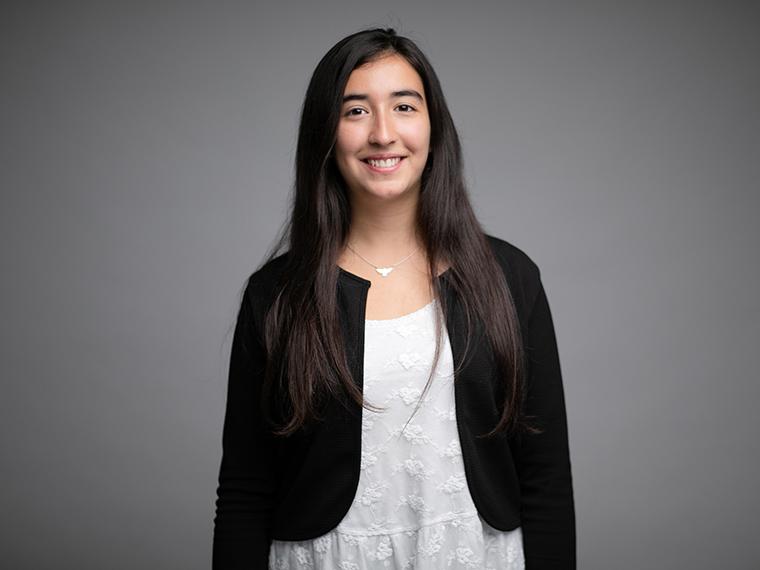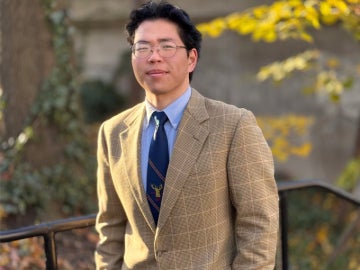Building Encouragement for Careers in Science and Technology
Abby Tejera Rocha has promoted women in STEM since she was a girl. Now she’s earning acclaim from an international tech firm.
November 11, 2022
Amanda Nagy

Abby Tejera Rocha is a second-year physics and computer science major. She is a finalist in an awards program sponsored by Globant, an international tech firm.
Photo credit: Office of Communications
Abby Tejera Rocha wants young people around the world to feel empowered to pursue careers in STEM fields. One way to do that is to increase the visibility of contemporary scientists and leaders in technology—including women such as herself.
A second-year physics and computer science double major, Tejera is a finalist voted to be a “Rising Star” in the Women that Build awards program, sponsored by the international tech company Globant. The award recognizes and promotes talented women leaders in technology. The Rising Star category distinguishes young women who are starting STEM careers and generating a positive impact on society.
A native of Maldonado, Uruguay, Tejera graduated as a GeneXus Analyst from Plan Ceibal, a free training program sponsored by the Uruguayan government. She performed so well that she was hired to tutor an Introduction to Programming class for more than 400 students between the ages of 18 and 30. Then came an offer to work for Globant, where she trained as an Android and app developer, and learned other programming languages.
Tejera was 16 when she founded an outreach project called Physic-ally Possible. Her goal was to disseminate knowledge of science and technology in accessible and entertaining ways. She interviewed scientists from all over the world, including the 2017 Nobel
Prize winners in physics, who are credited with having detected gravitational waves.
She was invited by Uruguay’s Ministry of Education and Culture and other organizations to participate in a series of videoconference interviews highlighting the possibilities for study and work in science and technology, with the aim of encouraging young people—particularly girls—to venture into those fields.
Tejera was admitted to Oberlin as an Early Decision applicant, making her dream of studying at Oberlin College come true. Her commitment to service and mentoring continues at Oberlin, where she is a Bonner Scholar, an America Counts leader, a STRONG scholar, and a student researcher in the lab of Associate Professor Jillian Scudder, as well as a Peer Advising Leader, a member of the Student Leadership Committee, and a peer tutor.
In the following Q&A, she discusses the importance of awakening vocations, motivating and supporting other young students, and giving visibility to contemporary role models in STEM.
How did you hear about the Women that Build awards program? What would this recognition mean to you?
I found out about the program when I received an email saying that I had been nominated in the “Rising Star” category of the awards. It was a great surprise, and I’ve been interested in the great work Globant does to recognize and highlight many women from STEM and information and computing technology.
Having been nominated—and later finding out that I am a finalist, thanks to a people's vote—is a great joy, and I am very grateful to all the people who support me unconditionally. It is very gratifying and at the same time a challenge to continue learning and improving day by day. I am also very grateful to the entire educational community of Oberlin College.
You started volunteering at a young age, and in your first two years at Oberlin, you’ve chosen experiences and taken positions that show your commitment to leadership and mentorship. What motivates you to help fellow students?
In my country, a program called Plan Ceibal was being implemented to bridge the existing digital gap in elementary schools. My parents were volunteers, and I accompanied them to distribute free computers with Linux and taught students how to use them. I will never forget those first smiles of the children—my peers—when seeing a computer for the first time.
I have participated in science camps with people from several countries, and I have created an app to make it easier for young people to find opportunities for science education. I also volunteered with an organization called Ceautismo, which works with children and young people with autism and raises awareness.
When I arrived at Oberlin, I found an incredible educational community that highly values the work of all students who are committed to society in one way or another. I have had the immense joy of being selected to participate in the Bonner Scholar program, which not only allows me to volunteer in various organizations, but trains us to do it in the best way. I would also like to highlight the great work that the Peer Advising Leaders Program (PAL) does to support all students during our first year at Oberlin, and I am really grateful for the opportunity of being a PAL and a member of that wonderful team that guides us.
What do you think are the most significant barriers to STEM education for young students, and what can be done to improve it?
If we ask young people about their favorite athlete, surely they have a role model or someone who inspires them. On the other hand, ask them to name a scientist who they know or inspires them, it is most likely that they name scientists like Albert Einstein or Marie Curie. In general, most young people can’t name or identify with contemporary women scientists, even though there are many and they are doing great things. This is why making visible the work of contemporary scientists helps to inspire, motivate, and awaken vocations in students who believe it is unattainable.
There is still a lot of work to be done to close the race and gender gaps that exist in some sectors. Just looking at the percentages of women who occupy management roles in research teams demonstrates that it is necessary to begin raising awareness and educating at a young age.
At Oberlin, I found an academic community that offers students lots of amazing opportunities to prepare ourselves for professional experiences and for thriving at STEM. For example, the STRONG Scholars program, the Office of Undergraduate Research, the Student Leadership Committee, and different resources and groups that contribute to the STEM education and the inclusion and equity in these areas.
What excites you about your studies in physics and computer science?
Physics, although we do not always realize it, is immersed in every activity that we carry out daily. The discipline contributes to the conservation and preservation of resources, through the approach of the scientific study of matter, energy, time, space, and the interactions of its components. The analysis of these interactions makes it possible to explain the properties and behavior of matter, and to gain an in-depth understanding of nature.
Personally, I’m really interested in astrophysics, an area that studies the bodies found in space, their movements, properties, and phenomena, but I am also interested in quantum mechanics and atomic physics.
I also love doing research in these areas and am really grateful to all my professors, who with vocation and dedication, provide students with an excellent academic experience. Currently, I am a student researcher with my mentor, Professor Jillian Scudder in the Physics and Astronomy Department of Oberlin, giving me the opportunity to be a researcher for her laboratory, and I’m really grateful for this opportunity. This is a great motivation and daily learning experience that lets me prepare myself in the best way possible.
I’m also excited about the future of computer science and how this profession can generate a positive impact on society. It’s important to educate people to be creative agents of the digital world and not just consumers.
You may also like…
Learning by Teaching: Oberlin Students Share Global Music with Young Learners
College and Conservatory students in PACE 103 prepare local children for an immersive community concert at Oberlin.
Nuiko Wadden ’02 Joins Oberlin Conservatory Faculty as Assistant Professor of Harp
The versatile musician brings extensive opera, orchestral, and contemporary music experience to her role
Leo Hidy ’23 Earns 2026 Marshall Scholarship
Leo Hidy ’23, a comparative American studies major who also studied business and economics while at Oberlin, has received a 2026 Marshall Scholarship that will fund two years of graduate study in the UK.


